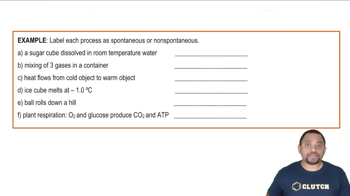Aqueous solutions of ammonia 1NH32 and bleach (active ingredient NaOCl) are sold as cleaning fluids, but bottles of both of them warn: 'Never mix ammonia and bleach, as toxic gases may be produced.' One of the toxic gases that can be produced is chloroamine, NH2Cl. (e) Is N oxidized, reduced, or neither, upon the conversion of ammonia to nitrogen trichloride?
Ch.20 - Electrochemistry
Chapter 20, Problem 116
Cytochrome, a complicated molecule that we will represent as CyFe2+, reacts with the air we breathe to supply energy required to synthesize adenosine triphosphate (ATP). The body uses ATP as an energy source to drive other reactions (Section 19.7). At pH 7.0 the following reduction potentials pertain to this oxidation of CyFe2+: O21g2 + 4 H+1aq2 + 4 e- ¡ 2 H2O1l2 Ered ° = +0.82 V CyFe3+1aq2 + e- ¡ CyFe2+1aq2 E°red = +0.22 V (a) What is ∆G for the oxidation of CyFe2+ by air? (b) If the synthesis of 1.00 mol of ATP from adenosine diphosphate (ADP) requires a ∆G of 37.7 kJ, how many moles of ATP are synthesized per mole of O2?
 Verified step by step guidance
Verified step by step guidance1
Step 1: Identify the half-reactions involved in the oxidation of CyFe^{2+} by O_2. The given half-reactions are: (1) O_2(g) + 4H^+(aq) + 4e^- \rightarrow 2H_2O(l) with E_{red}^\circ = +0.82 \text{ V} and (2) CyFe^{3+}(aq) + e^- \rightarrow CyFe^{2+}(aq) with E_{red}^\circ = +0.22 \text{ V}.
Step 2: Determine the overall cell reaction by reversing the second half-reaction (since it is an oxidation) and adding it to the first half-reaction. The oxidation reaction is: CyFe^{2+}(aq) \rightarrow CyFe^{3+}(aq) + e^-.
Step 3: Calculate the standard cell potential (E_{cell}^\circ) by subtracting the reduction potential of the oxidation half-reaction from the reduction potential of the reduction half-reaction: E_{cell}^\circ = E_{red}^\circ (O_2) - E_{red}^\circ (CyFe^{3+/2+}).
Step 4: Use the Nernst equation to calculate \Delta G^\circ for the overall reaction: \Delta G^\circ = -nFE_{cell}^\circ, where n is the number of moles of electrons transferred (4 in this case) and F is the Faraday constant (96485 C/mol).
Step 5: To find how many moles of ATP are synthesized per mole of O_2, divide the \Delta G^\circ of the reaction by the \Delta G required to synthesize 1 mole of ATP (37.7 kJ/mol). This will give the number of moles of ATP produced per mole of O_2.

Verified video answer for a similar problem:
This video solution was recommended by our tutors as helpful for the problem above.
Video duration:
4mWas this helpful?
Key Concepts
Here are the essential concepts you must grasp in order to answer the question correctly.
Reduction Potentials
Reduction potentials indicate the tendency of a chemical species to gain electrons and be reduced. A higher reduction potential means a greater likelihood of reduction occurring. In electrochemistry, these values are crucial for determining the direction of electron flow in redox reactions, which is essential for calculating Gibbs free energy changes.
Recommended video:
Guided course

Standard Reduction Potentials
Gibbs Free Energy (∆G)
Gibbs free energy is a thermodynamic quantity that measures the maximum reversible work obtainable from a thermodynamic system at constant temperature and pressure. The change in Gibbs free energy (∆G) during a reaction indicates whether the process is spontaneous (∆G < 0) or non-spontaneous (∆G > 0). It is calculated using the equation ∆G = -nFE, where n is the number of moles of electrons transferred, F is Faraday's constant, and E is the cell potential.
Recommended video:
Guided course

Gibbs Free Energy of Reactions
ATP Synthesis
Adenosine triphosphate (ATP) is the primary energy carrier in cells, synthesized from adenosine diphosphate (ADP) and inorganic phosphate (Pi) through processes like oxidative phosphorylation. The synthesis of ATP is coupled to exergonic reactions, such as the oxidation of cytochromes, which release energy. Understanding the relationship between the energy released in redox reactions and the energy required for ATP synthesis is key to determining how many moles of ATP can be produced from a given reaction.
Recommended video:
Guided course

Spontaneity of Processes Example
Related Practice
Textbook Question
Textbook Question
Cytochrome, a complicated molecule that we will represent as CyFe2+, reacts with the air we breathe to supply energy required to synthesize adenosine triphosphate (ATP). The body uses ATP as an energy source to drive other reactions (Section 19.7). At pH 7.0 the following reduction potentials pertain to this oxidation of CyFe2+: O21g2 + 4 H+1aq2 + 4 e- ¡ 2 H2O1l2 Ered ° = +0.8 (b) If the synthesis of 1.00 mol of ATP from adenosine diphosphate (ADP) requires a ∆G of 37.7 kJ, how many moles of ATP are synthesized per mole of O2?
